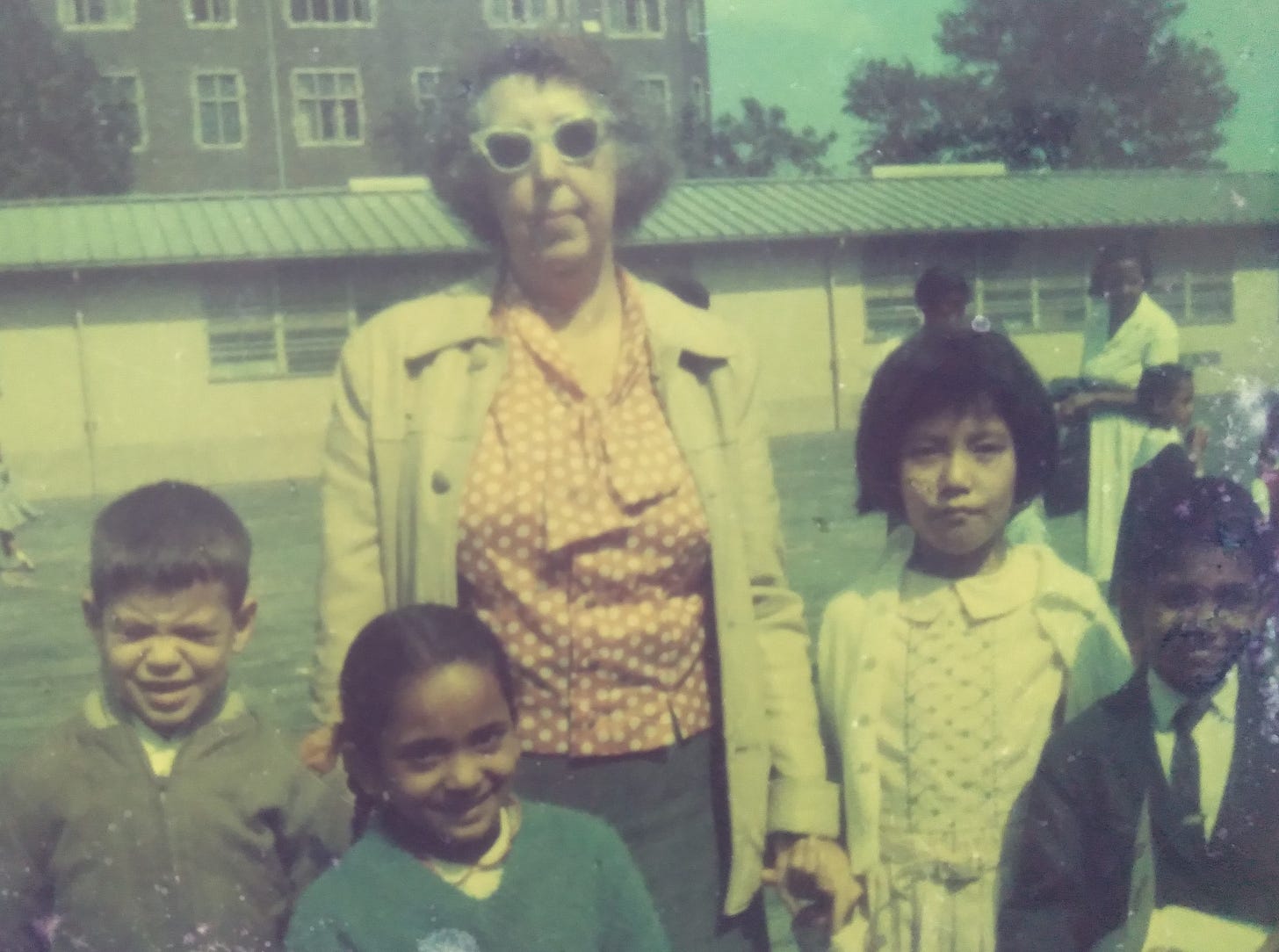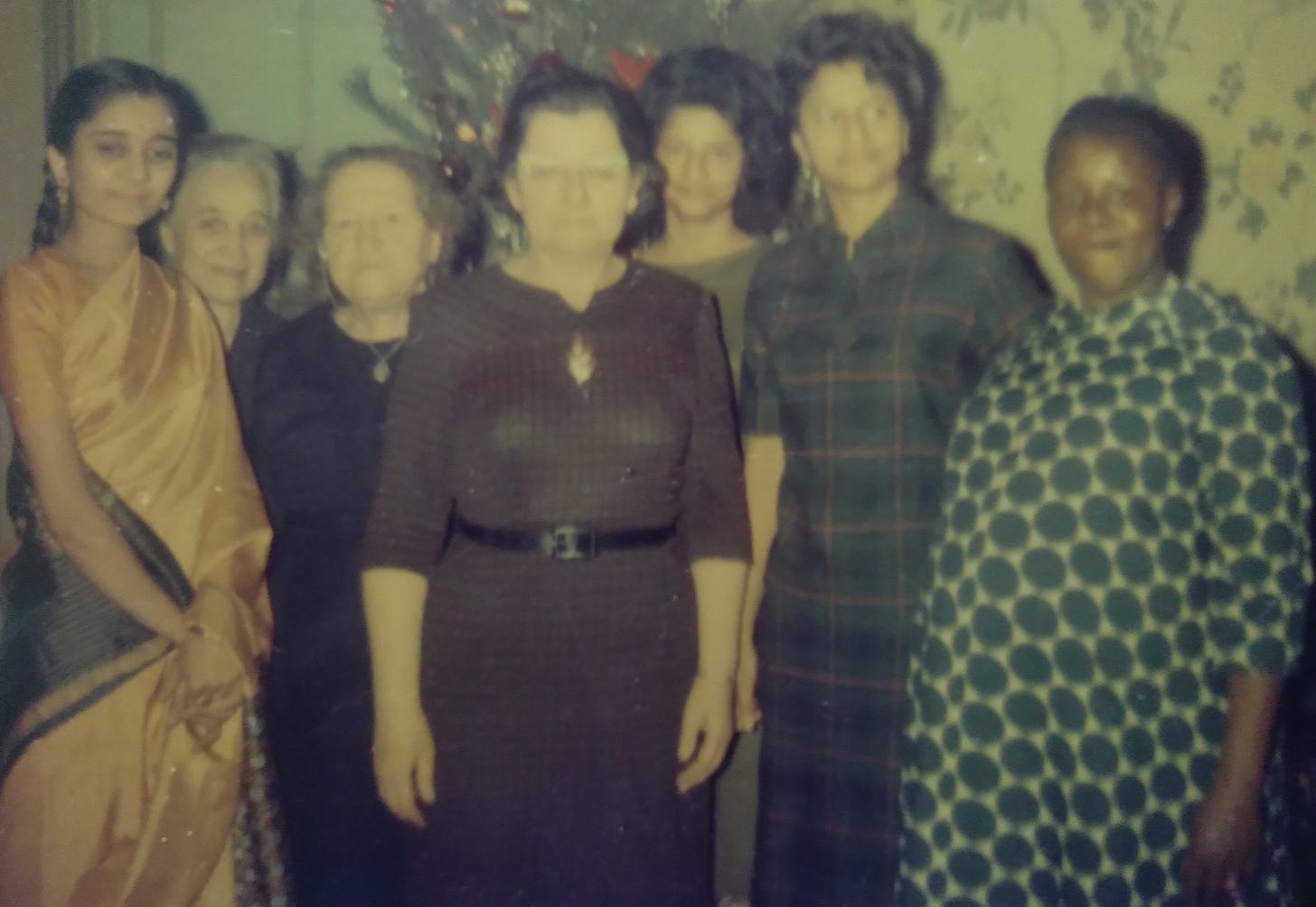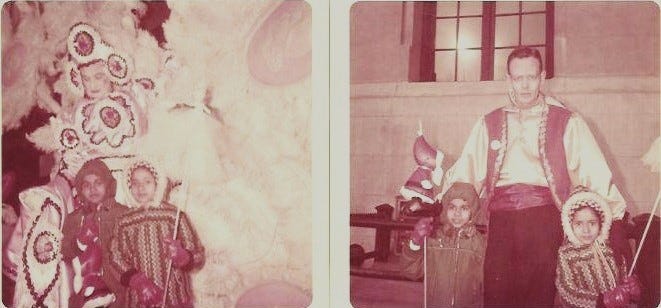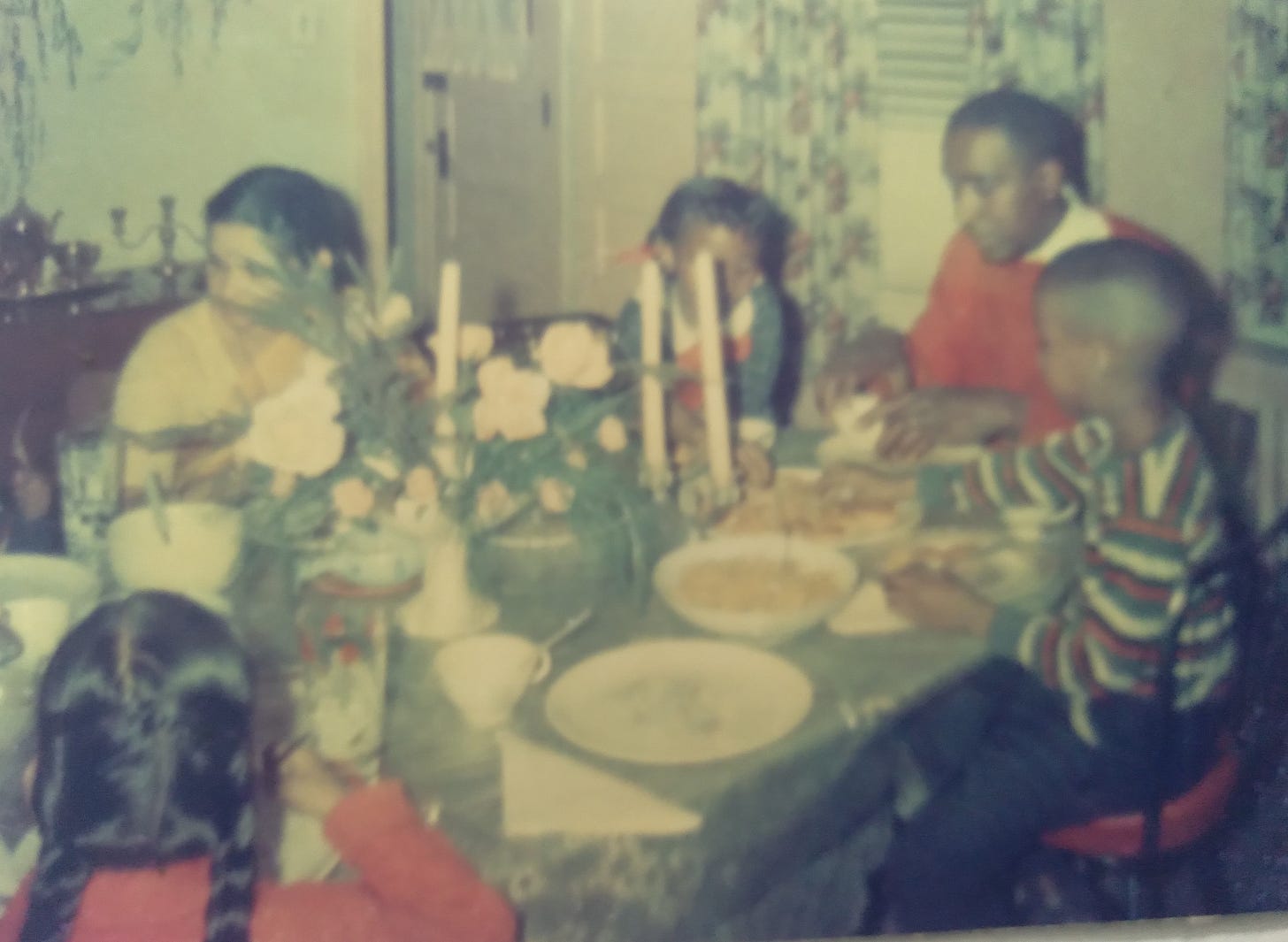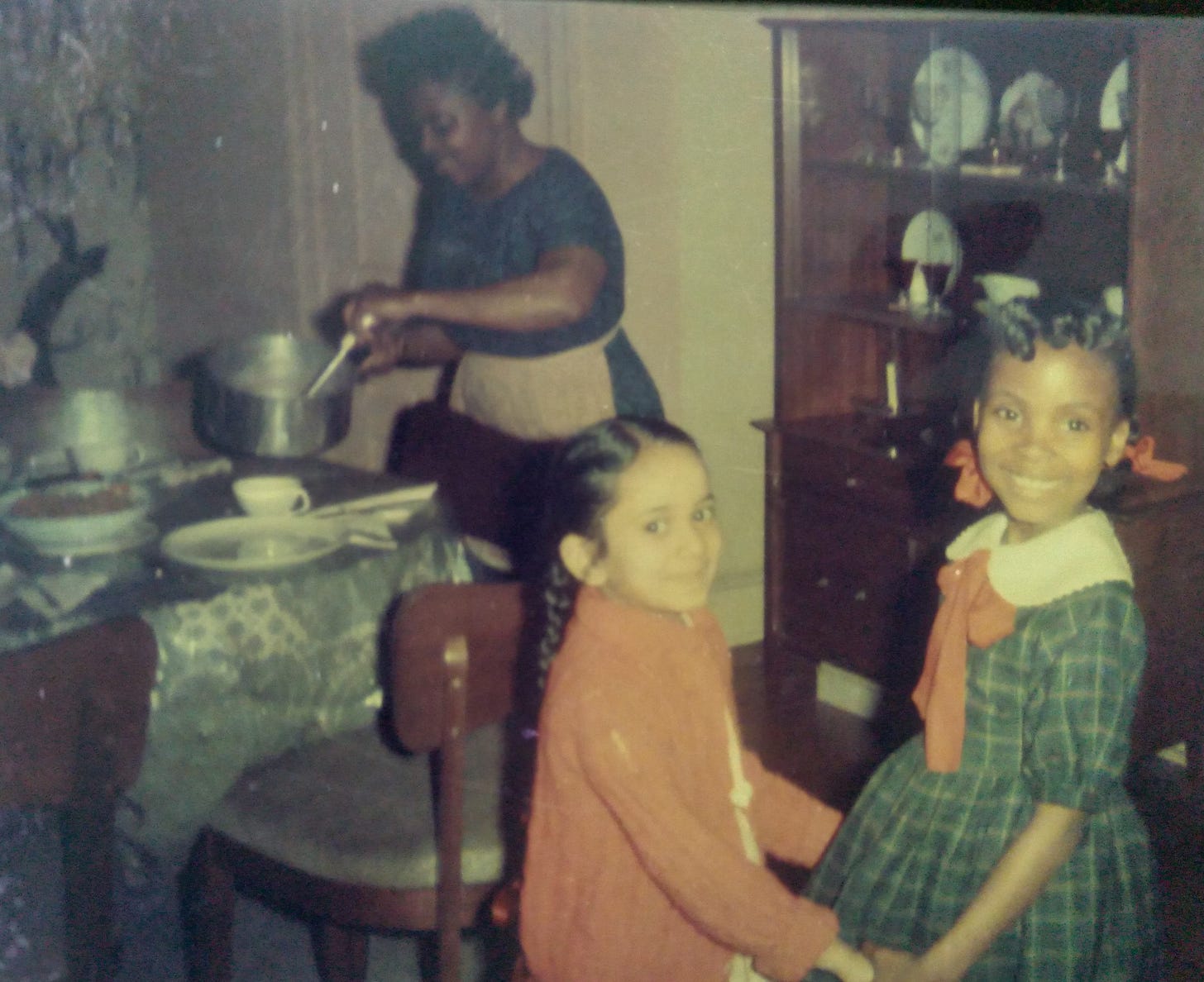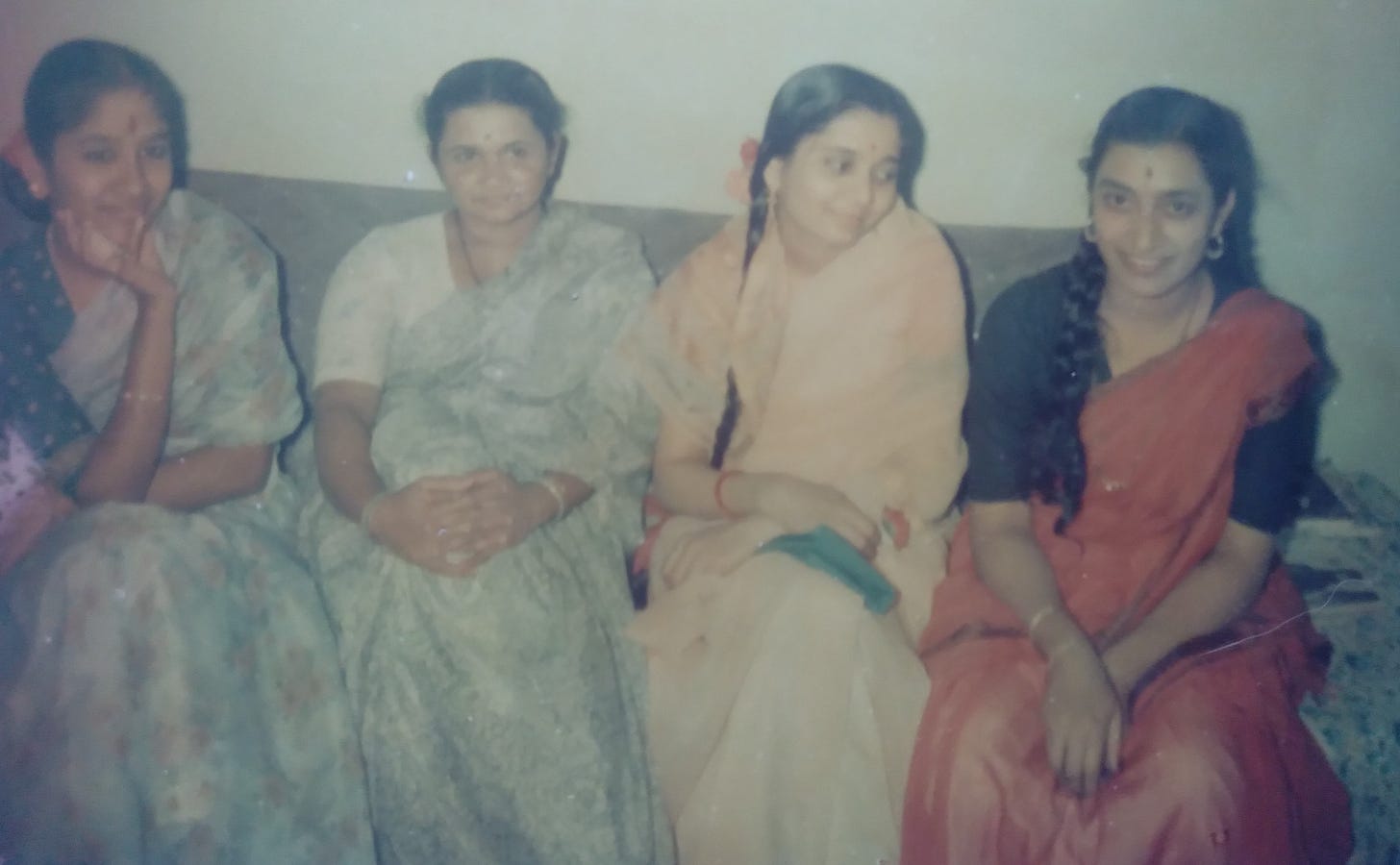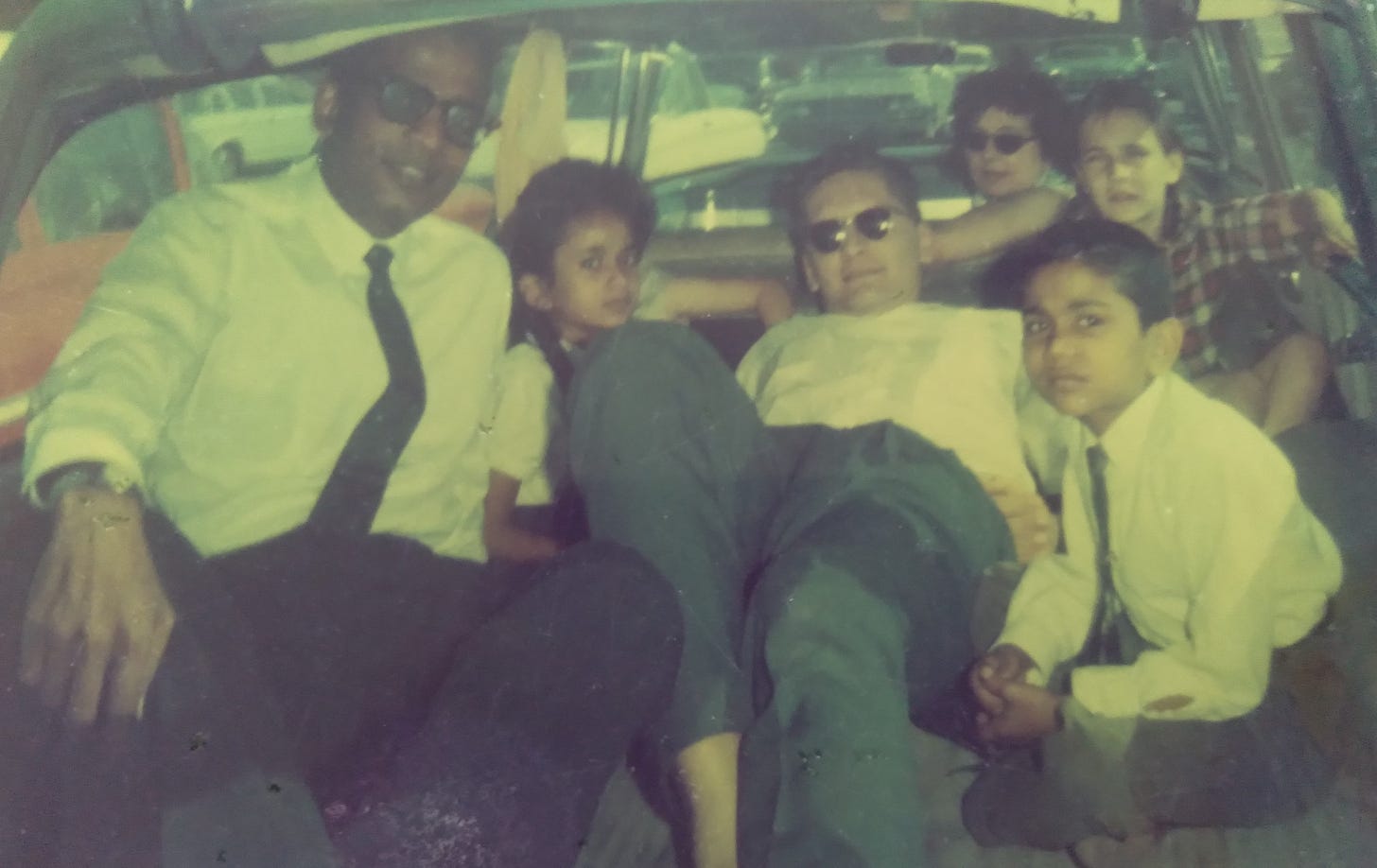An Indian Family In Philadelphia In The 1960s
Most Indians in Philadelphia in the 1960, many of them Maharashtrians, were at the University of Pennsylvania
(Photo: Shubha Kavadi, second from left, and Shirish Kavadi, right, with Ms. Applebaum, center, First Grade Teacher, Henry C. Lea, School, Philadelphia, 1962.©Shirish Kavadi.)
By Shirish N. Kavadi*
From 1960 to 1965, my father Naresh B Kavadi was in Philadelphia to help prepare teaching materials for the study of Marathi, the language of Maharashtra state, at the University of Pennsylvania (UPenn).
In 1962, my mother Kusumavati, younger sister Shubha, age 6, and me, age 7, joined him. UPenn covered the travel costs of only the spouse and two children. My older siblings Sharad and Shamala, who were in Marathi language high schools, stayed back in Solapur, India, living with my maternal uncles and aunt.
We lived in an apartment building at 135 South 40th street. It was opposite the Walnut Street branch of the Free Library of Philadelphia. The building was replaced by a McDonalds in the 1970’s.
At the library, my mother took free English language classes held for non-English speakers. Shubha and I became members of the library, borrowed books and watched children’s films which were screened there such as the French The Red Balloon.
We enrolled at the Henry C Lea School, part of the free public school district, on 47th and Locust Streets. The school, located in University City, was headed by Martin Warnick. It had a very good academic reputation, which was not surprising since several of the parents were either faculty members or employees of UPenn.
In the initial months, during our first year at school, my mother would take Shubha and me to and from the school by the city bus. Occasionally, our father would drop us at school.
A white parent, who was part of a car pool, offered to drop and pick us up from school. The pool comprised of parents of six students who belonged to the same church where one father was a minister. This arrangement lasted for only a few months.
During the second and third grades, Shubha and I would travel on our own by bus, with tokens bought at school. Often, in the spring and fall, after school ended at 3.30 pm, we would walk nine blocks to get home. Our mother would welcome us when we got to our building.
Elementary school students were not permitted to eat lunch in school. So, during our lunch break we would take a bus home. Our mother would walk four blocks, from her office at Bennett Hall on 36th Street to our apartment. She would serve us lunch which she had prepared that morning. After lunch, she would return to the office while Shubha and I took a bus back to school.
(Photo: Purnima Shah, left, with members of an English language class, Free Library of Philadelphia, Walnut Street, 1962. ©Shirish Kavadi.)
Our classmates were mostly whites from middle class families. There were some African Americans, most of them from low-income families. There were also students from Vietnam, Taiwan, Hong Kong, Japan, South Korea, Turkey, and India. Their fathers were doctoral or post-doctoral fellows and visiting scholars at UPenn, part of a “technocratic and scholarly elite”, as one U Penn report acknowledged.
My American classmates, even those from professional families, had no knowledge about India. When I said I was an Indian, they assumed I was a native American and asked the name of my tribe. None of the white students invited us to their homes. Shubha and I would often visit and play with Kiam Cua, a Chinese Hawaiian, who would also come to our apartment. Jeffery, an African American, once invited us for dinner. I am ashamed that I did not reciprocate.
Since we were part of a visitor exchange program at UPenn we had two local host families. One was white, the Aldermans whose children Stephen and Ruth were in school with us. From what I recall, Alderman was in the real estate business.
Our other host family were African Americans, the McNeils, whose children went to a different school. McNeil worked for the city administration of Philadelphia. They would visit us during Diwali and we would join them for Thanksgiving or Christmas dinner. We also attended church events with the McNeils.
(Photo: Shirish Kavadi, left, and Shubha Kavadi at Mummers Parade, Philadelphia, 1963. ©Shirish Kavadi.)
My mother learned English only after she got to Philadelphia. Her job, teaching spoken Marathi to graduate students at UPenn, gave her confidence. People would stop her on the streets, admiring her sari and asking her how she wore it. A bus driver, who was based in Kolkata during World War II, always greeted her with a Namaste.
In addition to her job at UPenn, my mother did the cooking and other household chores, unlike in India where she had hired help, which is still easily and cheaply available. In Philadelphia Shubha and I made our beds, washed dishes, swept the floors and helped mother with other chores. This good habit is still with us today.
A vegetarian, my mother cooked Maharashtrian Brahmin food such as rice with varan (pulses), rice with milk and yogurt, and spicy vegetables. During Diwali, the Hindu festival of lights in October, she prepared sweets like ladoos and karanjis and savories such as chivda, made from corn and rice flakes, and chaklis.
In the early 1960’s, there were no Indian grocery stores or restaurants in Philadelphia. My mother bought eggplant, pulses and spices at a Chinese grocery store. She also learned to prepare spaghetti with tomato sauce, sandwiches, soups, and green salads, all of which were new to us. She shopped at the Acme store on Market Street and, from around 1963, at Pennfruit, which opened on Walnut Street. On some weekends, as a family we would shop at the Reading Terminal Market in downtown Philadelphia.
Of course, my sister and I ate beef hot dogs at the school’s annual bazar day. My father encouraged us to taste meat and fish dishes, even though he did not develop a taste for them. He, Shubha, and I ate eggs at home. Our eating non-vegetarian food did not seem to bother my mother.
(Photo: Kavadi family at Thanksgiving Dinner hosted by the McNeills, Philadelphia, 1964. ©Shirish Kavadi.)
In India, I had little interest in school, turned off by the rote learning and by teachers who paid little attention and discouraged questions.
In Philadelphia, during my first, second and third grades, I was eager to go to school, even when it was snowing. Teachers pushed us to read, write and ask questions. I was among the five students, all Asians, who finished three English language readers in each grade. The readers were Dick, Jane, and Sally stories.
At that time, UPenn and Drexel University, which is also in Philadelphia, ran a Universities Related Schools program. It focused on English reading and comprehension, the teaching of foreign languages such as French and Spanish, and assisted schools set up libraries and hire librarians. I was ahead of most of my classmates in the weekly reading and comprehension exercises. I also wrote two short pieces for the school magazine Lea Echo.
I was however weak in math, especially compared to my Asian classmates. This was even though we were taught to understand the logic, unlike at my school in India where we had to memorize arithmetic tables.
(Photo: Shubha Kavadi, left, at Thanksgiving Dinner hosted by the McNeills, Philadelphia, 1964. ©Shirish Kavadi.)
Among my Indian schoolmates were Srilata Reddy, whose parents migrated to Philadelphia in the early 1950s; Sonia, whose father was at UPenn; and Gupta who was there for only about a year. Gupta’s father was an anthropologist who was killed by an avalanche while he was mountain climbing in the Himalayas.
In the early 1960s, there were few Indians in Philadelphia and most of them were associated with UPenn. They were young and from upper caste families in India, pursuing masters, doctoral and post-doctoral studies; only a few were UPenn employees. Many of them were Maharashtrians, along with some Bengalis, Tamilians, Punjabis, and Gujaratis.
When we arrived in Philadelphia, Sisir Gupta, a Bengali, had just finished his Masters in Political Science and was returning to India. His wife was a Maharashtrian and they had a young son Amit. We bought our TV and some utensils and dinner plates from them. Upon his return to India, Gupta taught at Jawaharlal Nehru University, Delhi. A Professor of Diplomatic Studies, he passed away in June 1978 at age 49.
My parents were the oldest among the Indians on campus. They would host regular gatherings of an informal Marathi Mandal (organization of Maharashtrians). Attendees included, Aravind K Joshi, (August 5, 1929-December 31, 2016), from Pune, India, who taught engineering at UPenn. At the time of his passing, he was a Professor Emeritus of Computer and Cognitive Science. His wife Susan Heyner was British. A biologist, she is an Emeritus Professor of Obstetrics and Gynecology at UPenn Medical School.
Avinash Bhagwat and his wife Seema, were both from Mumbai. Seema, a dietician and nutritionist, was the daughter of Anant Kanekar, a prominent Marathi writer and college teacher. She worked at the UPenn Hospital.
Mohan Khambadkone and his wife Lalita were Konkani speaking Saraswat Brahmins from Mumbai who also spoke Marathi. Lalita was a talented Veena player. Vasant Karmarkar, also from Mumbai, was afflicted by polio since early childhood.
Bhagwat, Khambadkone and Karmarkar were doctoral students in economics and finance. After earning their PhDs, they started careers at the World Bank and IMF in Washington DC. The Khambadkones lived in Bethesda, Maryland, near Washington DC. In 1974, Lalita was killed by their help who was brought from India to provide care for their young son.
Shyam Argade was from Pune while his wife Veena, who spoke Marathi, was a Kannadiga from Belgaum. Ramchandra Badchapay and his family were also from Pune. Argade and Badchapay took up jobs in the U.S., after earning PhDs in chemistry at UPenn. The Badchapays moved to Buffalo, New York, while the Argades went to Greensboro, North Carolina, where Veena set up a school to teach Bharat Natyam dance.
Shakuntala Bhagat (nee Joshi; 6 February 1933 – 14 October 2012), from Mumbai, was among India’s first women civil engineers. After securing a Master’s in civil and structural engineering at UPenn, she returned to Mumbai. Initially she taught at the Indian Institute of Technology, Mumbai. She then set up Bhagat Engineering. She and her husband also set up Quadricon, which designed bridges in India, the U.S., United Kingdom, and Germany.
Panna Naik (1933- present) and her husband, who were Gujaratis from Mumbai, were part of the Marathi Mandal since they spoke Marathi. Panna was a bibliographer in South Asia Studies and later taught Gujarati, both at UPenn. She is known for her Gujarati poems and short stories.
The economist D. R. Gadgil, who my father knew from Pune, India, was a Visiting Research Fellow at U Penn. His wife Pramila and my mother became good friends and she would often baby sit Shubha and me.
(Photo: Kusumavati Kavadi, Revathi Vaidyanathan, Purnima Shah, and Veena Argade, from left. Philadelphia, 1963. ©Shirish Kavadi.)
The other Indian families with whom we socialized included S. Vaidyanathan, who taught Tamil, his wife Revathi and son Dilip. Later they divorced, with Revathi staying on in the U.S. and marrying a North Indian. I heard they set up an Indian restaurant. There were the Merchants, son and mother, both of whom PhD students. Also, Purnima Shah, from Ahmedabad, whom my mother met at her English language class. Her husband, an engineer, was pursuing a PhD at U Penn.
Other visitors to our apartment included the family of Franklin Southworth, who invited my father to work with him on the Marathi texts. A few times we visited the Southworth family at Swarthmore, a Philadelphia suburb, and also stayed at his family farm in Little Compton, Rhode Island. At Diwali, guests at our apartment also included American UPenn graduate students Eleanor Zelliot, Mary Carras, Maxine Berntsen, Peggy Bush, and Ted Riccardy.
On weekends and during the Christmas break, we traveled in and around Philadelphia: Wanamaker and Gimbels stores, Independence Hall, Philadelphia Museum of Art, the Please Touch Museum, Fairmount Park, Longwood Gardens; the Betsy Ross House, the Valley Forge National Historical Park, the amusement park at Springfield, and Atlantic City, in nearby New Jersey.
We visited New York City, including during the World’s Fair, 1964-1965, Washington DC, and New Haven, where Yale University is located. Some of the longer journeys were family trips on Amtrak trains or Greyhound buses or with Indian friends bundled into two or three cars. In late 1963, my father bought a used blue Rambler. He did not drive it often and certainly not on highways. The car was often driven by friends when we went sight-seeing or on picnics with us.
Eating out with Indian friends, including on the trips, meant ordering cheese pizzas at a pizzeria since the women, like my mother, were vegetarians.
(Photo: top - Naresh and Kusumawati Kavadi, right, with Seema and Avinash Bhagwat. Below right: With Bhagwat and Argade families. Below left: with Joshi and Bhagwat families. Philadelphia, 1963. ©Shirish Kavadi.)
We saw Indian temple sculptures, from the 8th to 12th century, displayed at the home of Stella Kramrisch (1896 -1993). She was a professor at UPenn and curator of Indian art at the Phladelphia Museum of Art. Joan, a student who was taking care of Kramrisch’s house while she was traveling abroad, invited us to view the collection.
An event at UPenn still fresh in my memory was the visit of India’s President S. Radhakrishnan on June 5, 1963.
Shubha and I watched a fair amount of TV. On weekdays we watched the nightly news. I recall images from the assassination of President John F Kennedy; Dr Martin Luther King’s march to Washington DC demanding the end of segregation and civil rights for African Americans; and the funerals of Prime Minister Jawaharlal Nehru of India and Winston Churchill of Great Britain.
After school hours and on Saturday mornings, we watched cartoons such as Caspar the friendly Ghost, Mighty Mouse, westerns such as The Lone Ranger, Roy Rogers, and Wagon Train, Sky King, and children shows like Sally Starr and The Wonderful World of Disney. We also enjoyed American Bandstand. We never missed The Wizard of Oz which was shown on TV every December 6.
In theatres in downtown Philadelphia, we watched: Mary Poppins; the musical South Pacific; The Defiant Ones, starring Tony Curtis and Sidney Poitier; Marlon Brando’s One-Eyed Jack; Charlton Heston’s Diamond Head; and Cleopatra with Elizabeth Taylor, Richard Burton and Rex Harrison.
At a festival of Indian films at UPenn, I saw Satyajit Ray’s Apu triology and Devi. Also, screened were Bollywood films such as Anuradha, with Balraj Sahani and Leela Naidu, and Tere Ghar Ke Samane, with Dev Anand and Nutan.
In 1965, upon returning to India, the transition from the Lea school in Philadelphia to schools in Solapur, India, was tough for both Shubha and me. I got letters from four Lea classmates, in part as it was an assignment given by our teacher. I regret not replying to them. Later, I became a regular letter writer to my school and university friends.
Today, Indians in the U.S. total around 4.5 million, including those from the second generation. In San Jose, California, Queens, New York, Edison, New Jersey, and in several other American cities and towns there are streets lined with Indian grocery stores and restaurants. Each day, there is wide media coverage in India about Indians in America, including founders of technology companies, chief executives, academic deans, surgeons, owners of motels, cigarette and liquor stores, presidential candidate Kamala Harris who is half Indian, Usha Vance, the Indian wife of Donald Trump’s running mate J.D. Vance, and fraudsters sentenced to prison.
Living in Philadelphia in the early 1960s, from age 7 to 10, shaped me into pursuing teaching, research and writing as well as enjoying TV shows and films.
(Photo: The Kavadi and Southworth Families, Longwood Gardens, Pennyslvannia, 1962. ©Shirish Kavadi.)
* Shirish N Kavadi, is a medical historian and health policy researcher based in Pune, India. Earlier he taught Political Science at Patkar and other colleges in Mumbai University (1980-1988) and SNDT University, Mumbai, (1988-1992). In 2011, he earned his PhD in history from Mumbai University.



